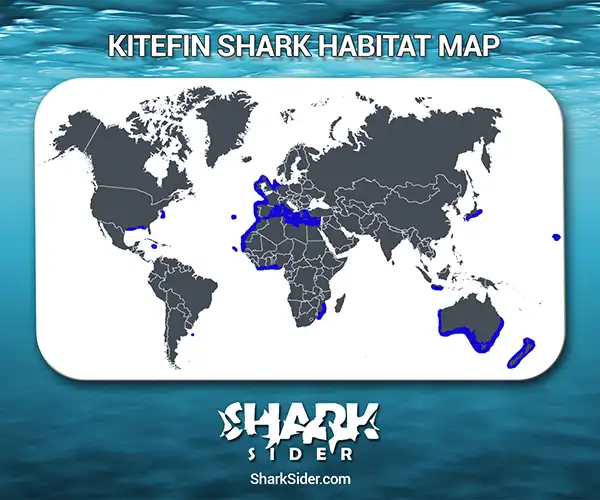The kitefin shark, or seal shark, is the largest shark species that produces its own light and is the largest vertebrate capable of bioluminescence. It lives in the ocean’s depths, where it can be spotted close to the sea floor, floating without spending too much energy.
Kitefin Shark Scientific Classification |
|
| Kingdom | Animalia |
| Phylum | Chordata |
| Class | Chondrichthyes |
| Order | Squaliformes |
| Family | Dalatiidae |
| Genus | Dalatias |
| Scientific Name | D. licha |
Description
Most kitefin sharks have a moderately long body, reaching 3.3–4.6 ft in length. The longest specimen reported was either 5.2 or 5.9 ft. On average, these sharks weigh 18 lb.
Their eyes and spiracles are enormous compared to the rest of their face. The shark has a small rounded snout, and its lips are thick with fringes. Inside the mouth, one can see 16–21 rows of teeth in the upper jaw and 17–20 in the lower one. The teeth present in the upper part of the shark’s mouth are curved slightly and spike-shaped, while those in the lower jaw are serrated and knife-shaped, forming a continuous cutting surface.
The first dorsal fin is slightly smaller than the second dorsal fin. This shark has a set of short and round pectoral fins and a caudal fin with an upper lobe.
These sharks are uniformly gray or brown, with some having black spots dorsally. While most fins have transparent fins, the caudal fin has a black tip.
Where do they live
Map Of The Kitefin Shark’s Habitat

Interestingly despite its broad, almost global, range, this shark seems to be separated off into separate populations that do not seem to interact with each other. The places where the kitefin shark has been spotted include the Azores, the British Isles, Cameroon, the Georges Bank, the Gulf of Mexico, Madeira, parts of the Mediterranean Sea, and the North Sea in the Atlantic, Mozambique, and South Africa in the Indian Ocean, and Australia, the Hawaiian Islands, Japan, Java, and New Zealand.
These sharks are commonly seen at 660–1,970 ft depths but have also been captured at 5,900 ft. They live on the outer continental shelves and upper continental slopes, as well as around oceanic islands and seamounts.
Behavior
Hunting
This shark feeds on a wide variety of bony fish, including barracudinas, bonito, bristlemouths, cod, deepwater cardinalfishes, deepwater scorpionfishes, deepwater smelts, greeneyes, grenadiers, lanternfishes, scaly dragonfishes, sea toads, snake mackerels, and viperfishes. But their diet also includes crustaceans, octopi, polychaete worms, siphonophores, skates, squids, and smaller sharks like sawtail catsharks and spurdogs. They even take bites out of larger prey like sharks and whales.
As they are slow swimmers, they are believed to scavenge on dead and decayed faster fish.
Social
While they are primarily solitary, these sharks sometimes form same-sex groups.
Reproductive
They are viviparous, giving birth to 10-16 pups after a gestation period of around two years. Initially, the newborns are 12-18 inches long. Sexual maturity is observed in males at 2.53–3.97 ft and 3.84–5.22 ft in females.
Adaptations
The most notable thing about this shark is its ability to glow in the dark. It does this with the help of photophores on its front or belly. This helps draw prey towards themselves or hide themselves using counter-illumination camouflage.
These sharks have enormous livers, helping the shark maintain buoyancy and stay above the bottom of the ocean floor.
Interactions with humans
While this shark lives at depths where it cannot be considered a threat to humans, it has been exploited by fishing activities both directly and indirectly. The shark’s liver is harvested for its oil, and the meat and offal are consumed in certain parts of the world. This shark mostly ends up as bycatch, and even when released, they fail to return to the proper depths and either die out or are preyed on by larger sharks.
The most notable case of human exploitation of these sharks was from the 1970s to the 1990s off the Azores coast, explicitly targeting it. Unfortunately, like several deep-sea species, it has a low reproductive rate, and the overfishing caused the population to drop steeply. As a result, the IUCN classified this shark as “Vulnerable” or “VU”.
